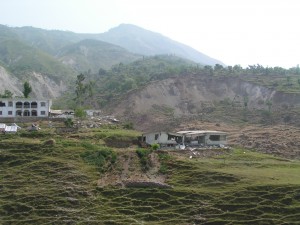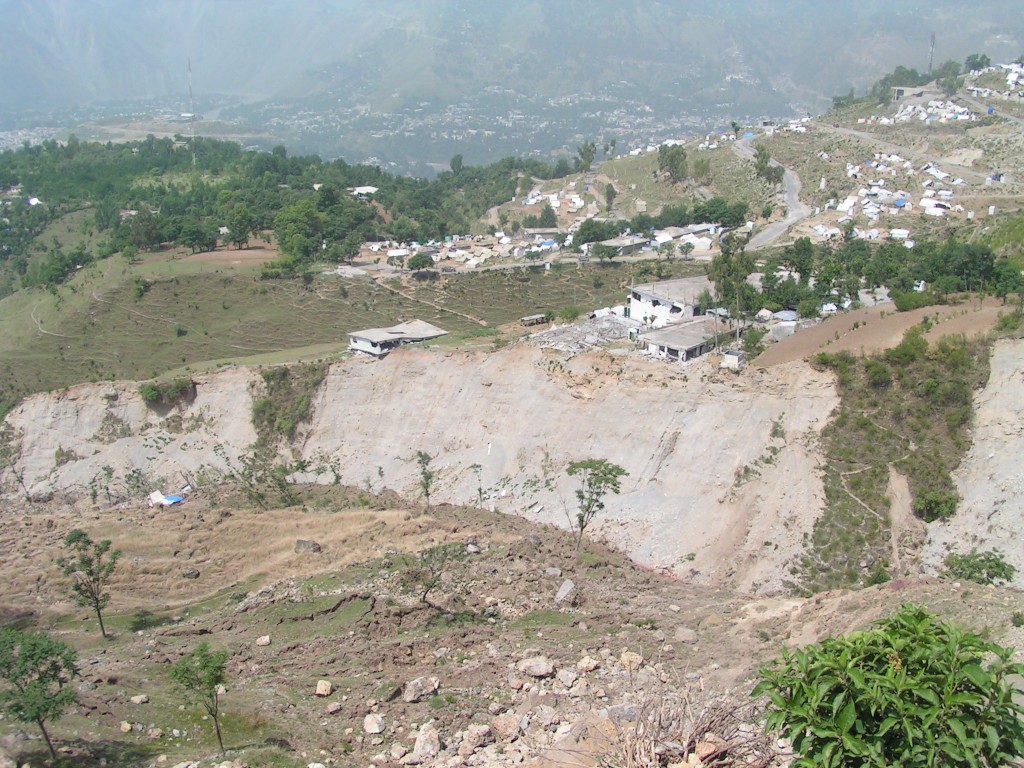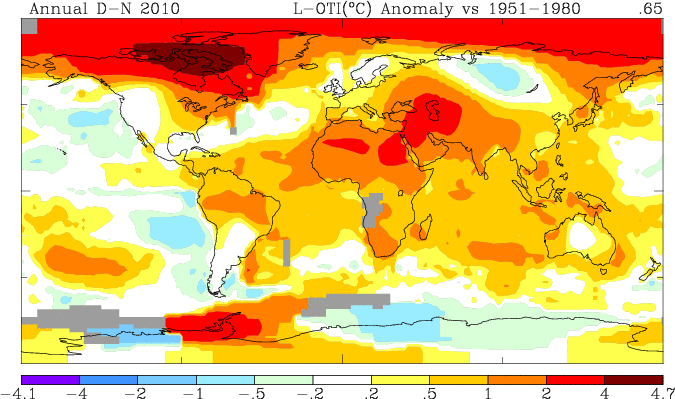21 December 2010
Community-based landslide warning systems
Posted by Dave Petley
 An increasingly important area of work in landslides is the development of tools to generate warnings to potentially-affected communities. Whilst technologically-led examples have been available for a couple of decades now, and have proven to be quite effective, the growing emphasis is on low tech approaches that can be operated by and within communities. This is entirely pragmatic – we know that most of the severe losses, whether measured in terms of lives lost or in proportion of per capita GDP, occur in less developed countries, particularly in Asia and Latin America. Unfortunately, the problems are so widespread, and in many cases so large that engineering-led mitigation is impossible, even if sufficient resource was available (and usually of course it is not). A good example appeared in the Pakistan media today, with reports of multiple locations across northern Pakistan in which active landsliding is affecting rural communities. Undoubtedly, communities in Pakistan are very sensitive to these issues at the moment, but the threats posed by landslides in these upland areas, especially in the context of climate change, are very real. (By way of illustration the two photos in this post are both communities affected by landslides in Kashmir, Pakistan).
An increasingly important area of work in landslides is the development of tools to generate warnings to potentially-affected communities. Whilst technologically-led examples have been available for a couple of decades now, and have proven to be quite effective, the growing emphasis is on low tech approaches that can be operated by and within communities. This is entirely pragmatic – we know that most of the severe losses, whether measured in terms of lives lost or in proportion of per capita GDP, occur in less developed countries, particularly in Asia and Latin America. Unfortunately, the problems are so widespread, and in many cases so large that engineering-led mitigation is impossible, even if sufficient resource was available (and usually of course it is not). A good example appeared in the Pakistan media today, with reports of multiple locations across northern Pakistan in which active landsliding is affecting rural communities. Undoubtedly, communities in Pakistan are very sensitive to these issues at the moment, but the threats posed by landslides in these upland areas, especially in the context of climate change, are very real. (By way of illustration the two photos in this post are both communities affected by landslides in Kashmir, Pakistan).
A stock response to these threats is to suggest relocation of the population, but this is rarely a satisfactory approach. As I have noted before, poor people balance the risks in their lives in a rather sophisticated way. The immediate risks that people face are associated with access to clean water, sanitation, food, health care and education. Relocation may serve to reduce the risks associated with the landslide, but more often than not increases these more immediate risks, leaving the people worse off.
 Thus, a pragmatic solution is to try to develop warning systems. Of course these must be as reliable as possible, but they must also be based upon a technology that will work in the setting on which they are located. Critically, the warning system needs to be operated by the local population for two key reasons. First, a locally-run warning system is most likely to actually operate in the difficult conditions e.g. (heavy rainfall) that occur during a potential landslide. Second, local buy-in means that the system is more likely to be trusted and, in particular, it reduces the chances of the population growing weary of the inevitable false alarms. This requires that the system is essentially simple and understandable, and that a huge effort must be made to work with the local community to achieve buy-in.
Thus, a pragmatic solution is to try to develop warning systems. Of course these must be as reliable as possible, but they must also be based upon a technology that will work in the setting on which they are located. Critically, the warning system needs to be operated by the local population for two key reasons. First, a locally-run warning system is most likely to actually operate in the difficult conditions e.g. (heavy rainfall) that occur during a potential landslide. Second, local buy-in means that the system is more likely to be trusted and, in particular, it reduces the chances of the population growing weary of the inevitable false alarms. This requires that the system is essentially simple and understandable, and that a huge effort must be made to work with the local community to achieve buy-in.
A nice example of such an approach is provided in a media report from the Philippines today. Here, a World Bank funded project, undertaken with the Center for Initiatives and Researches on Climate Change Adaptation (CIRCA) and the University of the Philippines-Los Baños, has sought to develop a low tech community warning system for the town of Manito in Albay. The system is based upon the principle that a rainfall threshold can be identified at which point landslides start to become likely – this is the same basis for the sophisticated Hong Kong warning system. Recycled plastic bottles are used to measure rainfall, and manually-operated bells are used to provide the warning. Underpinning this is a training programme to ensure that local communities both understand the warning system and know how to react when the alert occurs. In addition, the education programme is designed to build environmental awareness within the community, thus addressing one of the chronic problems that increases landslide occurrence in rural villages.
I hope that we will see many similar initiaves over the next few years in rural communities, underpinned with sharing of successes and failures such that we can learn from each other. The combination of population growth, resource pressures and of course climate change is going to make this essential. And, just in case you believe the reports in the right wing press that the current high profile cold weather in Europe and parts of the US is an indication that climate change is at an end, the following two NASA maps are a remarkable wake-up call. The first map shows temperature for the last 12 months (i.e. December 2009 to November 2010, which of course includes the cold weather in Europe in the first part of 2010): measured against the longer term mean. Clearly red is above average and blue is below:
The second is the anomaly for November 2010:
Not many reasons to be cheerful there.




 Dave Petley is the Vice-Chancellor of the University of Hull in the United Kingdom. His blog provides commentary and analysis of landslide events occurring worldwide, including the landslides themselves, latest research, and conferences and meetings.
Dave Petley is the Vice-Chancellor of the University of Hull in the United Kingdom. His blog provides commentary and analysis of landslide events occurring worldwide, including the landslides themselves, latest research, and conferences and meetings.
Dr.Petley,there is news that there is an imminet threat of a landslide in Thoi valley,Northern Areas of Pakistan.Have you received any alerts on this?